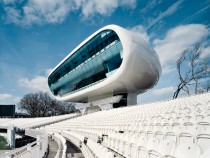
© Richard Davies
Steel buildings traditionally consist of a structure and a non-load-bearing outer and/or inner envelope. This division into the skin and bones is not efficient constructionally, because each non-load-bearing element represents a form of ballast that demands larger dimensions for the structural members.
Monocoques, in contrast, are a type of building in which an internal linear framework and a load-bearing skin form a structural whole. An analogy exists to the outer shells of insects and crustacea. This highly efficient lightweight form of construction has established itself above all in shipbuilding.
Monocoques, in contrast, are a type of building in which an internal linear framework and a load-bearing skin form a structural whole. An analogy exists to the outer shells of insects and crustacea. This highly efficient lightweight form of construction has established itself above all in shipbuilding.


















